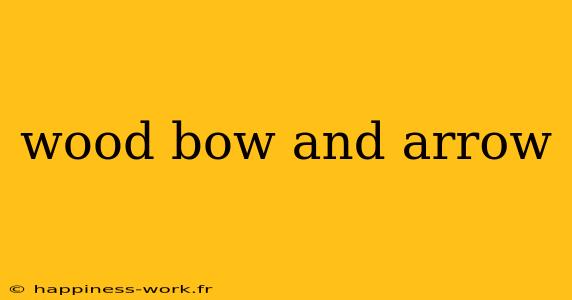Creating your own wooden bow and arrow can be an exciting and rewarding project. Not only does it connect you with traditional archery practices, but it also allows you to appreciate the craftsmanship that goes into making these classic hunting and sport tools. In this article, we’ll explore the steps to create a wood bow and arrow, answer common questions from the community, and provide additional insights to enhance your understanding.
Understanding the Basics
Why Choose Wood for Your Bow?
Wood has been used for millennia to craft bows due to its natural strength and elasticity. Traditional materials like yew, osage orange, or hickory are known for their excellent performance. For beginners, softwoods such as pine or fir can also be suitable for creating a basic bow.
Analysis:
Wood offers a unique aesthetic quality, making each bow a piece of art. The choice of wood can also impact the performance, including speed, draw weight, and durability.
Tools You Will Need
To create a wooden bow and arrow, you’ll need a set of tools. Here are the essentials:
- Hand Saw: For cutting the wood to the desired length.
- Rasp: To shape the bow limb.
- Sandpaper: For smoothing out any rough edges.
- Bow String: Typically made of Dacron or natural fibers.
- Arrow Shafting: Can be made from wood, aluminum, or carbon.
Practical Example:
If you have access to a local lumberyard, ask for straight-grained wood that is free from knots or defects.
Step-by-Step Instructions
1. Selecting Your Wood
Choose a straight piece of wood around 6-8 feet long and 1-2 inches thick. Ensure the wood is seasoned to prevent warping.
2. Shaping the Bow
Using your saw, cut the wood to the desired length. Begin shaping the bow by creating a gentle curve. Use your rasp to remove material evenly from both sides, creating limbs that taper toward the ends.
3. Crafting the Bowstring
For the bowstring, measure out the length needed (usually about 3 inches shorter than the bow). If using Dacron, make sure it's suitable for the weight of the bow.
4. Making Arrows
Select straight wooden dowels or bamboo poles for arrows. Cut them to about 28-32 inches long. Add nocks at the rear end and fletching for stabilization.
5. Testing the Bow
Carefully string your bow and perform a few test draws. Make adjustments as needed to ensure a smooth pull.
Common Questions
How Do I Maintain My Wooden Bow?
Maintaining your bow is crucial for longevity. Keep it dry, store it in a cool place, and periodically check for signs of wear. Waxing the string can also help it last longer.
Attribution: This information is adapted from the community insights shared on WikiHow, where contributors provide valuable archery tips.
What Are the Best Woods for Bow Making?
While yew and osage orange are traditional favorites, other excellent options include:
- Maple: A great choice for a beginner bow.
- Bamboo: Known for its flexibility and strength.
Can I Use a Bow for Target Practice?
Absolutely! Whether in your backyard or a designated archery range, practicing with your homemade bow and arrow can significantly improve your accuracy and technique.
Conclusion: The Art of Traditional Archery
Creating a wooden bow and arrow not only revives ancient skills but also encourages self-sufficiency and craftsmanship. As you embark on this journey, remember to enjoy the process of learning and experimenting with different materials and techniques.
Additional Tips for Success
- Join a Community: Engaging with local archery clubs or online forums can provide invaluable tips and support.
- Document Your Progress: Take notes and pictures throughout the process to track improvements and learn from mistakes.
- Stay Safe: Always use safety gear and follow local laws regarding archery practice.
By understanding the fundamentals of bow and arrow making, you’ll deepen your appreciation for this timeless skill. Whether for sport or hunting, a handmade wooden bow and arrow can become a cherished companion on your outdoor adventures.
Feel free to explore further resources for more intricate bow-making techniques and engage with other enthusiasts online for inspiration and advice!
